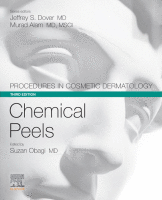Physical Address
304 North Cardinal St.
Dorchester Center, MA 02124

Introduction Considering that skin resurfacing is, for the most part, an elective procedure, the tolerance for complications is very low on the part of the patient. For the physician, resurfacing the skin involves creating a controlled injury to the skin…

Introduction This special topic chapter explores a still pioneering aspect of deep chemical peeling using phenol–croton oil formulas. Although the basic concepts of safety, perioperative care, formulas, and the application of deep chemical peeling were well covered by Dr. Richard…

In this day and age of high technology, younger patients and surgeons often think that only devices or new technology is the answer to skin rejuvenation. Although contemporary technology has in fact opened new doors, the historic chemical peel still…

Introduction Minor acne scarring occurs in up to 95% of acne cases, and 22% of these patients are affected with a more significant and psychologically disturbing degree of scarring (as reported by Layton et al., 1994). Various treatment modalities are used…

Introduction The phenol peel has been called a chemical facelift because it removes photodamage-related wrinkles and tightens the skin more effectively than other ablative techniques. To accomplish this, a deep croton oil–phenol peel extends to the upper to midreticular dermis…

Introduction Postacne scarring is the most important sequelae for acne and can be psychologically traumatic to the patient. It can occur even in patients with milder degrees of acne. The pathogenesis of atrophic acne scarring is most likely related to…

Introduction Acne vulgaris is an exceedingly common inflammatory condition with a lifetime prevalence approaching 80%. Acne has been associated with depression, anxiety, and low self-esteem; untreated or poorly managed acne often has major effects on patient quality of life and…

Introduction The low cost and reliable results of chemical peeling have made it a staple procedure in aesthetic medicine. The American Society of Plastic Surgeons ranked chemical peels as the third most popular cosmetic minimally invasive procedure in 2018, with…

The results of phenol–croton oil peeling, also known as deep chemical peeling, are considered the gold standard in the treatment of the aged face. Historically, in the “pre–energy-based devices era,” it was almost the only option for radical facial skin…

Introduction The history of phenol–croton oil peels dates back to the 1920s, when they were introduced into the United States by “lay peelers” coming from Europe. The formulas involved boiling crystals to obtain liquid phenol, to which were added drops…